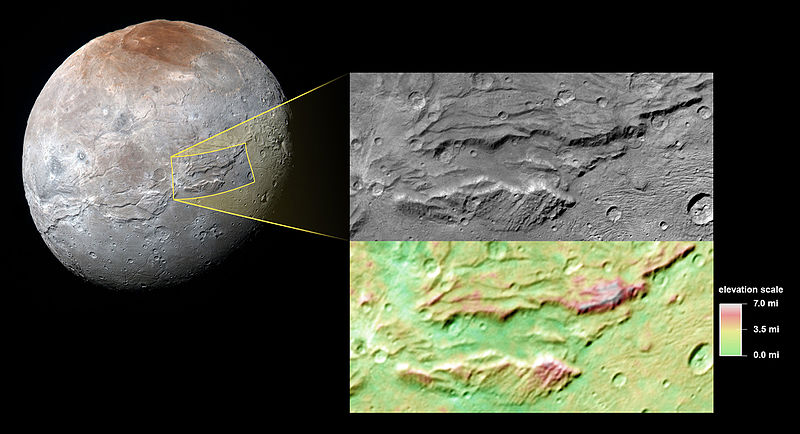File:Charon SerenityChasma Context 02182016 Melded.jpg

Original file (3,600 × 1,951 pixels, file size: 2.44 MB, MIME type: image/jpeg)
Captions
Captions
| DescriptionCharon SerenityChasma Context 02182016 Melded.jpg |
English: Images from NASA’s New Horizons mission suggest that Pluto’s largest moon, Charon, once had a subsurface ocean that has long since frozen and expanded, pushing out on the moon’s surface and causing it to stretch and fracture on a massive scale.
The side of Charon viewed by the passing New Horizons spacecraft in July 2015 is characterized by a system of “pull apart” tectonic faults, which are expressed as ridges, scarps and valleys—the latter sometimes reaching more than 4 miles (6.5 kilometers) deep. Charon’s tectonic landscape shows that, somehow, the moon expanded in its past, and –like Bruce Banner tearing his shirt as he becomes the Incredible Hulk – Charon’s surface fractured as it stretched. Charon’s outer layer is primarily water ice. When the moon was young this layer was warmed by the decay of radioactive elements, as well as Charon’s own internal heat of formation. Scientists say Charon could have been warm enough to cause the water ice to melt deep down, creating a subsurface ocean. But as Charon cooled over time, this ocean would have frozen and expanded (as happens when water freezes), pushing the surface outward and producing the massive chasms we see today. The top segment focuses on a section of the feature informally named Serenity Chasma, part of a vast equatorial belt of chasms on Charon. In fact, this system of chasms is one of the longest seen anywhere in the solar system, running at least 1,100 miles (about 1,800 kilometers) long and reaching 4.5 miles (7.5 kilometers) deep. By comparison, the Grand Canyon is 277 miles (446 kilometers) long and just over a mile (1.6 kilometers) deep. The lower portion of the image shows color-coded topography of the same scene. Measurements of the shape of this feature tell scientists that Charon’s water-ice layer may have been at least partially liquid in its early history, and has since refrozen. This image was obtained by the Long-Range Reconnaissance Imager (LORRI) on New Horizons. North is up; illumination is from the top-left of the image. The image resolution is about 1,290 feet (394 meters) per pixel. The image measures 240 miles (386 kilometers) long and 110 miles (175 kilometers) wide. It was obtained at a range of approximately 48,900 miles (78,700 kilometers) from Charon, about an hour and 40 minutes before New Horizons’ closest approach to Charon on July 14, 2015. |
||||||
| Date | |||||||
| Source | http://pluto.jhuapl.edu/Multimedia/Science-Photos/pics/Charon_SerenityChasma_Context_02182016_Melded.jpg | ||||||
| Author | NASA/Johns Hopkins University Applied Physics Laboratory/Southwest Research Institute | ||||||
| Permission (Reusing this file) |
|
File history
Click on a date/time to view the file as it appeared at that time.
| Date/Time | Thumbnail | Dimensions | User | Comment | |
|---|---|---|---|---|---|
| current | 06:52, 19 February 2016 |  | 3,600 × 1,951 (2.44 MB) | PlanetUser (talk | contribs) | Transferred from http://pluto.jhuapl.edu/Multimedia/Science-Photos/pics/Charon_SerenityChasma_Context_02182016_Melded.jpg |
You cannot overwrite this file.
File usage on Commons
The following page uses this file:
File usage on other wikis
The following other wikis use this file:
- Usage on es.wikipedia.org
Metadata
This file contains additional information such as Exif metadata which may have been added by the digital camera, scanner, or software program used to create or digitize it. If the file has been modified from its original state, some details such as the timestamp may not fully reflect those of the original file. The timestamp is only as accurate as the clock in the camera, and it may be completely wrong.
| Width | 1,976 px |
|---|---|
| Height | 1,976 px |
| Bits per component |
|
| Pixel composition | RGB |
| Orientation | Normal |
| Number of components | 3 |
| Horizontal resolution | 72 dpi |
| Vertical resolution | 72 dpi |
| Software used | Adobe Photoshop CS6 (Macintosh) |
| File change date and time | 20:44, 16 February 2016 |
| Exif version | 2.21 |
| Color space | Uncalibrated |
| Date and time of digitizing | 02:50, 23 September 2015 |
| Date metadata was last modified | 12:44, 16 February 2016 |
| Unique ID of original document | xmp.did:A39DA90527206811808380E541AC1428 |

